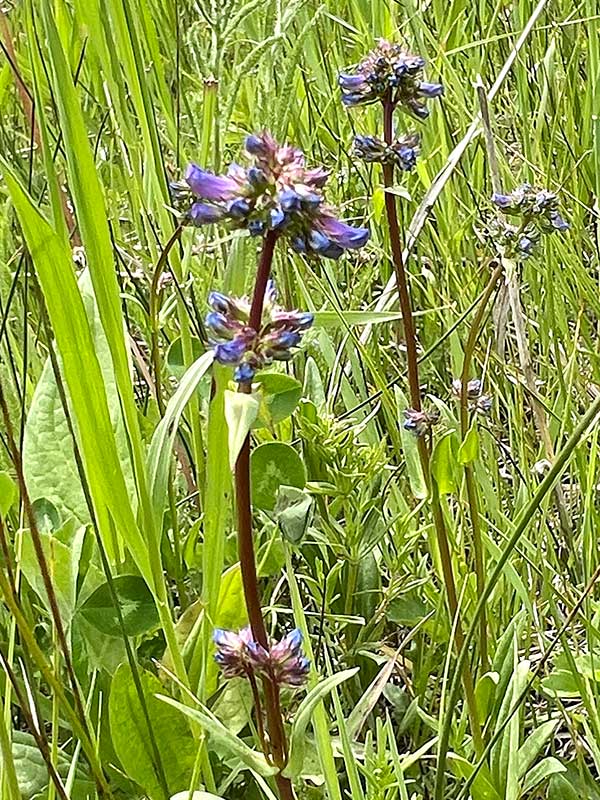Penstemon rydbergii / Rydberg’s penstemon
- small, blue/purple tubular flowers in leafy whorls
- flowers lack glands or hairs
- basal rosette of bright green, spoon-shaped leaves without glands or hairs
- stem leaves are lanceolate, around flower clusters
- wetter areas, but also along Victor/Driggs bike path
Also known as: meadow beardtongue, mountain meadow beardtongue
Rydberg’s penstemon is a native perennial. Compared to other penstemons, it has relatively small (half-inch) flowers. Most notably, these are clustered in dense, leafy whorls that stick straight out from the stems, unlike other penstemons (e.g. blue penstemon) which have the flowers mostly on one side of the stems and are often hanging down. The terminal clusters give the plant a round-topped look.
Like other penstemons, Rydberg’s has tubular flowers opening into two lips at the wide end. In this case, the petals are blue or purple and the stamens are yellow or golden. The base of the corolla is white. The flowers lack glands, unlike other penstemons, so they’re smooth. The size and shape of the individual flowers attracts small bees that crawl into the floral tube to drink nectar, in the process moving pollen around. Hummingbirds and butterflies are also welcome. The flowers are open for a good part of spring and into August, depending on weather and water availability.
Rydberg’s penstemon grows a basal rosette of bright green leaves from a woody caudex. The leaves are perhaps 2 inches long and “spoon shaped”. They lack hairs or glands. Above the rosette, upper stem leaves are lance-shaped and sessile.
Rydberg’s penstemon grows in wet rocky soils, moist meadows and open slopes of foothills. It is also one of the species planted along the bike path between Victor and Driggs.
Interesting bits – This species was named for Per Axel Rydberg, a Swedish born American botanist who worked in the upper plain states and the Rocky Mountains. Although he was well respected, and the first curator of the New York Botanical Garden herbarium, his colleagues were reported to make fun of him. It seems that in plant taxonomy, there are two types of botanists, the “lumpers” and the “splitters”. Lumpers tend to group species that they think are similar, yea identical, into a single species. Splitters tend to find small differences and create new species names based on them. Rydberg described 1700 new species, and one of his colleagues said he could create a new species based only on the number of worm holes in the leaves. That is, he was the ultimate splitter.
| Blossom size | |
|---|---|
| Color | |
| Family | |
| Inflorescence size | |
| Inflorescence type | |
| When? | |
| Where? |

